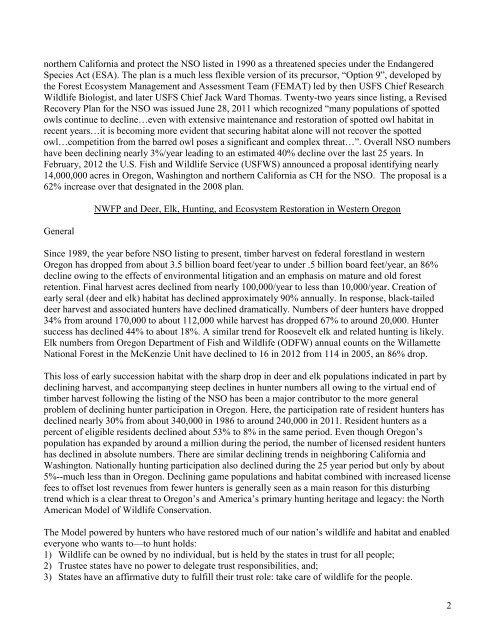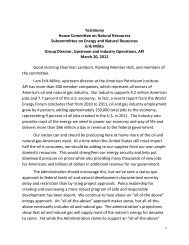Mr. Stephen Mealey - The House Committee on Natural Resources ...
Mr. Stephen Mealey - The House Committee on Natural Resources ...
Mr. Stephen Mealey - The House Committee on Natural Resources ...
Create successful ePaper yourself
Turn your PDF publications into a flip-book with our unique Google optimized e-Paper software.
northern California and protect the NSO listed in 1990 as a threatened species under the Endangered<br />
Species Act (ESA). <str<strong>on</strong>g>The</str<strong>on</strong>g> plan is a much less flexible versi<strong>on</strong> of its precursor, “Opti<strong>on</strong> 9”, developed by<br />
the Forest Ecosystem Management and Assessment Team (FEMAT) led by then USFS Chief Research<br />
Wildlife Biologist, and later USFS Chief Jack Ward Thomas. Twenty-two years since listing, a Revised<br />
Recovery Plan for the NSO was issued June 28, 2011 which recognized “many populati<strong>on</strong>s of spotted<br />
owls c<strong>on</strong>tinue to decline…even with extensive maintenance and restorati<strong>on</strong> of spotted owl habitat in<br />
recent years…it is becoming more evident that securing habitat al<strong>on</strong>e will not recover the spotted<br />
owl…competiti<strong>on</strong> from the barred owl poses a significant and complex threat…”. Overall NSO numbers<br />
have been declining nearly 3%/year leading to an estimated 40% decline over the last 25 years. In<br />
February, 2012 the U.S. Fish and Wildlife Service (USFWS) announced a proposal identifying nearly<br />
14,000,000 acres in Oreg<strong>on</strong>, Washingt<strong>on</strong> and northern California as CH for the NSO. <str<strong>on</strong>g>The</str<strong>on</strong>g> proposal is a<br />
62% increase over that designated in the 2008 plan.<br />
General<br />
NWFP and Deer, Elk, Hunting, and Ecosystem Restorati<strong>on</strong> in Western Oreg<strong>on</strong><br />
Since 1989, the year before NSO listing to present, timber harvest <strong>on</strong> federal forestland in western<br />
Oreg<strong>on</strong> has dropped from about 3.5 billi<strong>on</strong> board feet/year to under .5 billi<strong>on</strong> board feet/year, an 86%<br />
decline owing to the effects of envir<strong>on</strong>mental litigati<strong>on</strong> and an emphasis <strong>on</strong> mature and old forest<br />
retenti<strong>on</strong>. Final harvest acres declined from nearly 100,000/year to less than 10,000/year. Creati<strong>on</strong> of<br />
early seral (deer and elk) habitat has declined approximately 90% annually. In resp<strong>on</strong>se, black-tailed<br />
deer harvest and associated hunters have declined dramatically. Numbers of deer hunters have dropped<br />
34% from around 170,000 to about 112,000 while harvest has dropped 67% to around 20,000. Hunter<br />
success has declined 44% to about 18%. A similar trend for Roosevelt elk and related hunting is likely.<br />
Elk numbers from Oreg<strong>on</strong> Department of Fish and Wildlife (ODFW) annual counts <strong>on</strong> the Willamette<br />
Nati<strong>on</strong>al Forest in the McKenzie Unit have declined to 16 in 2012 from 114 in 2005, an 86% drop.<br />
This loss of early successi<strong>on</strong> habitat with the sharp drop in deer and elk populati<strong>on</strong>s indicated in part by<br />
declining harvest, and accompanying steep declines in hunter numbers all owing to the virtual end of<br />
timber harvest following the listing of the NSO has been a major c<strong>on</strong>tributor to the more general<br />
problem of declining hunter participati<strong>on</strong> in Oreg<strong>on</strong>. Here, the participati<strong>on</strong> rate of resident hunters has<br />
declined nearly 30% from about 340,000 in 1986 to around 240,000 in 2011. Resident hunters as a<br />
percent of eligible residents declined about 53% to 8% in the same period. Even though Oreg<strong>on</strong>’s<br />
populati<strong>on</strong> has expanded by around a milli<strong>on</strong> during the period, the number of licensed resident hunters<br />
has declined in absolute numbers. <str<strong>on</strong>g>The</str<strong>on</strong>g>re are similar declining trends in neighboring California and<br />
Washingt<strong>on</strong>. Nati<strong>on</strong>ally hunting participati<strong>on</strong> also declined during the 25 year period but <strong>on</strong>ly by about<br />
5%--much less than in Oreg<strong>on</strong>. Declining game populati<strong>on</strong>s and habitat combined with increased license<br />
fees to offset lost revenues from fewer hunters is generally seen as a main reas<strong>on</strong> for this disturbing<br />
trend which is a clear threat to Oreg<strong>on</strong>’s and America’s primary hunting heritage and legacy: the North<br />
American Model of Wildlife C<strong>on</strong>servati<strong>on</strong>.<br />
<str<strong>on</strong>g>The</str<strong>on</strong>g> Model powered by hunters who have restored much of our nati<strong>on</strong>’s wildlife and habitat and enabled<br />
every<strong>on</strong>e who wants to—to hunt holds:<br />
1) Wildlife can be owned by no individual, but is held by the states in trust for all people;<br />
2) Trustee states have no power to delegate trust resp<strong>on</strong>sibilities, and;<br />
3) States have an affirmative duty to fulfill their trust role: take care of wildlife for the people.<br />
2
















